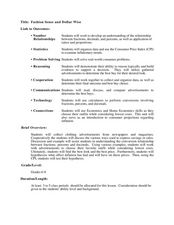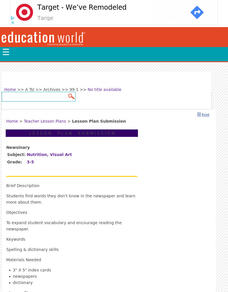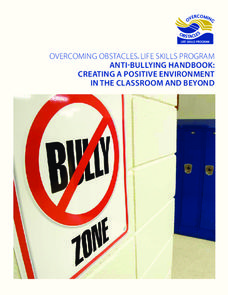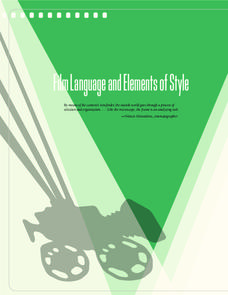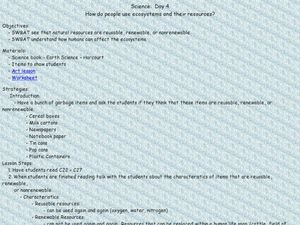Curated OER
Fashion Sense and Dollar Wise
Students work in groups to show understanding of the relationship between fractions, decimals, percentages, and the application of ratios and proportions. In this decimals, fractions, and percents lesson, students use real life consumer...
Curated OER
Kindness Graffiti Wall
Students discuss acts of kindness. In this character education lesson plan, students use a large sheet of poster paper, tempera paint, and markers to create a graffiti wall. Students write down their ideas of kindness and share their...
Curated OER
Move it Like An Animal
Students investigate how animals move. In this animals lesson plan, students use pictures of animals and demonstrate how each of them moves from place to place.
Curated OER
Overcoming Censorship Through Art
Students create an art piece that expresses their opinions while circumventing hypothetical government restrictions in this lesson on art and government censorship. Emphasis is placed upon historical instances of censorship around the...
Curated OER
Newspapers in Cyberspace: Journalism's Digital Future
Ninth graders complete a unit of lessons on how the Internet is used as a resource for journalists. They visit a newspaper office, conduct Internet research, conduct an interview, and write a newspaper article using their researched...
Curated OER
"Newsinary"
Here is a good way to use newspapers in the classroom and build a functional vocabulary. Learners are given 26 cards, they write one letter of the alphabet on each. They search the paper to find a name, place, or word for each letter,...
Overcoming Obstacles
Anti-Bullying Handbook: Creating a Positive Environment in the Classroom and Beyond
A hot-button topic in schools today is bullying, and although there is heightened awareness of this problem, information about specific steps schools can take to combat the problem and create a positive environment is difficult to find....
Film Foundation
Film Language and Elements of Style
How do you read a frame? How do you read a shot? Here's a resource that shows viewers how to read films. As part of the study, class members examine the camera angles, lighting, movement, and cinematic point of view in Mr. Smith Goes to...
Curated OER
Lead Stories about Confederation Lesson 5
Students identify what a lead story is and how to write one, for their simulated newspaper, about Confederation. They use primary-source documents from the "EvidenceWeb" portion of the Learning Centre, on the Library and Archives Canada...
Curated OER
The Use of Printed Page- Newspapers, magazines and advertising
Students study the process of making paper. In this papermaking instructional activity students see the benefits of a printed page and creat their own paper.
Curated OER
What's New? Translating Foreign Newspapers With Word
Students copy and paste foreign newspaper articles into a Word document, convert the passage to table format and then use the table to translate the words of the original article into English.
Curated OER
ADULT ESOL LESSON PLAN--Concepts of Time and Money
Students identify different denominations of United States currency and symbols associated with money and reading prices. In addition, in pairs they identify examples of currency from newspapers and magazines.
Curated OER
Newspaper on the Civil War
Students create historically accurate newspapers. In this Civil War lesson, students research Internet and print sources regarding the events, battles, and personalities of the war. Students collaborate to publish newspapers that feature...
Curated OER
Newspapers
Students create a class newspaper about the Olympics. In this newspaper lesson, students discuss the basic characteristics of each component of the newspaper. Students work in small groups to complete stations on cartoons, headlines,...
Curated OER
Newspaper Writing on Flight in History
Students read about important events in history through newspaper articles. In this newspaper lesson, students look at different writing styles and author's bias in different articles about the same event. They write their own articles...
Curated OER
How do people use ecosystems and their resources?
Students examine how natural resources are reusable, renewable or nonrenewable. In this ecosystems lesson students see the effects humans have on ecosystems and complete an art lesson activity.
Curated OER
Historical Background of Nightjohn Lesson Plan
Eighth graders use first-hand slave narratives that show conditions of slavery. They paste text into Appleworks and publish with a picture clipped from web sites. They create a group account of life during slavery to prepare for reading...
Curated OER
Spacing Out on the Internet
Young scholars explore and locate information about the universe using the Internet.
Curated OER
Propaganda/Stereotypes Used in the Media
Students write a character sketch on a television character who they feel is a stereotype. In this propaganda/stereotype instructional activity, students discuss the definition of the terms and ways that the media uses both. Students...
Curated OER
Lesson Plan: The Black Press
Students examine the history of the black press. In this media awareness lesson, students watch videos and conduct research regarding the history of the black press in America. Students explore media careers as they read provided...
Curated OER
Using the Very, Very Simple Climate Model in the Classroom
Students study the relationship between the average global temperature and carbon dioxide emissions. In this weather lesson students develop a test scenario using a model then read and interpret graphs of data.
Curated OER
Seeking, Locating, Accessing, and Using Information
Students complete reserach on a topic of their choice by following the Big Six research program. In doing so, students locate information and assess the validity and usefulness of sources.
Curated OER
ESL What Do We Like Doing? Using the Correct Word
In this ESL what do we like doing sentence completion activity, students choose the correct word, from a given pair, to complete each of 8 sentences. They rewrite the sentence correctly on the line beneath the given sentences.


